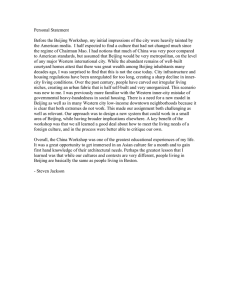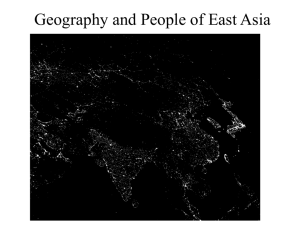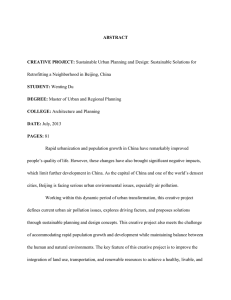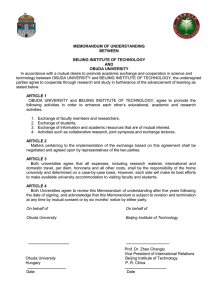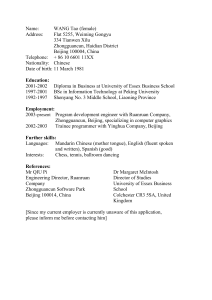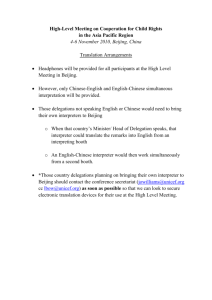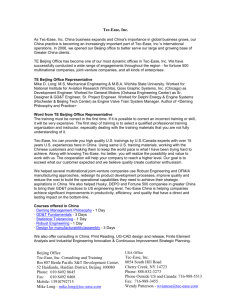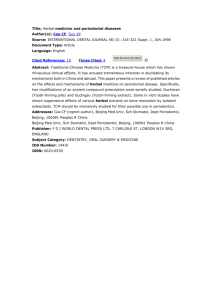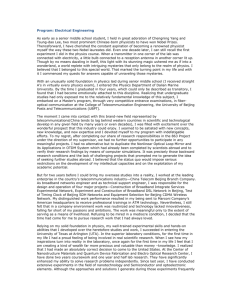Natural Resources Summit compressed
advertisement
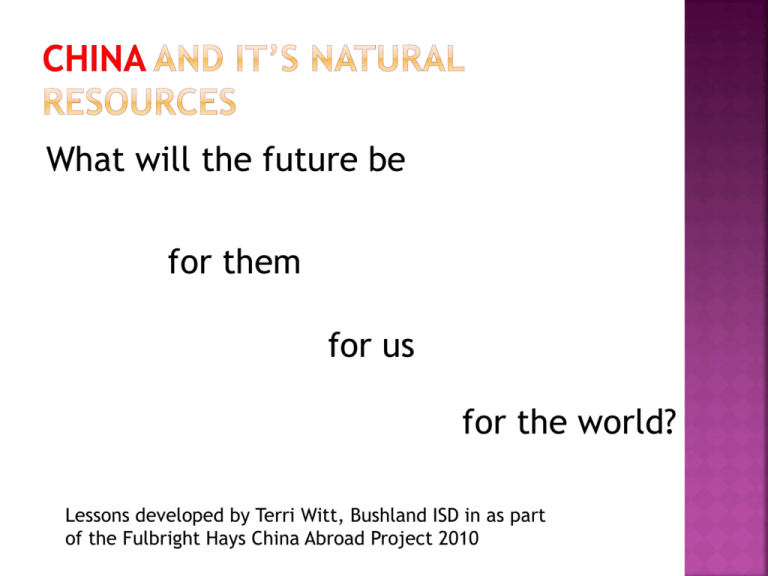
What will the future be for them for us for the world? Lessons developed by Terri Witt, Bushland ISD in as part of the Fulbright Hays China Abroad Project 2010 113.18. Social Studies, Grade 6 (3) Geography (D) create thematic maps, graphs, charts, models, and databases depicting aspects such as…economic activities of various world regions and countries. (8) Economics (A) describe ways in which the factors of production (natural resources, labor, capital) influence the economics of various contemporary societies (B) identify problems and issues that may arise when one or more of the factors of production is in relatively short supply and (C) explain the impact of relative scarcity of resources on international trade and economic interdependence among and within societies. For much of the past century China was closed off from the rest of the world The Communist government meant a command economy In 1982 they began experimenting with market economy 1984 saw light industries operating in small towns and villages 1993 – present highest development rate in China’s history Total of U.S. and Japan combined http://www.indexmundi.com/energy.aspx?co untry=cn View coal mining video clips. These clips are produced by U.S. coal companies. http://www.coaleducation.org/miningtv/pan dt_small.htm Have you ever seen a mining operation. What surprised you? Both this source and the conservation source on the previous slide may have bias. Can you identify? http://www.indexmundi.com/minerals/?cou ntry=cn&product=iron ore&graph=production To date, there have been relatively few systematic studies of the growing economic relations between China and Africa. That is why the IMF has undertaken a study to quantify— pulling together available information, which is far from complete— China’s economic engagement with Africa. The hope is that through a better understanding of the relationship, we can identify how African countries might best position themselves to reap the biggest possible gains. Two-way trade flows between Africa and China have been growing rapidly. Between 2001 and 2006, Africa’s exports to and imports from China rose on average by more than 40 percent and 35 percent, respectively, significantly higher than the growth rate of world trade (14 percent) or commodities prices (18 percent). In dollar terms, for both imports and exports, the increase in that period was from about $10 billion to more than $55 billion (see Chart 1). China is now Africa’s third largest trading partner after the United States and the European Union. Its share in Africa’s annual export growth has almost doubled since 2000 China's energy productivity is well below the world average. In 2006, the country used 15 percent of global energy to achieve about 6 percent of global GDP. The Chinese government is determined to change that and now has one of the world's most aggressive energy efficiency programs, promising to reduce the country's energy use intensity by 20 percent between 2006 and 2010. A goal for China is to reduce reliance on coal, which is used to produce more than three-quarters of China's electricity and is the largest contributor to global warming pollution. Studies have shown that increased energy efficiency in China could cut the nation's growth in energy demand in half and reduce greenhouse gas emissions by up to 50 percent in 2030 over projected levels. Our main focus is on helping China develop large-scale incentive programs that use a portion of electricity rates to fund energy efficient technologies. This is known as demand-side management, or DSM.The concept can also be described as helping China build virtual "efficiency power plants." Our landmark DSM program in Jiangsu Province was lauded by Premier Wen Jiabao as a model for the rest of the country. U.S. Secretary of State Hilary Clinton hailed it as a model for U.S.-China energy cooperation. NRDC also helped China's government develop tough lighting and efficiency standards for commercial buildings and new electronic equipment. The goal is to rapidly reduce carbon dioxide emissions and other forms of pollution while easing the pressure for China to build new coal-fired power plants. This is done by: Demonstrating success in individual factories Providing intensive training for local leaders and experts, who can in turn train others. Assisting China in developing a national framework to measure and verify the energy savings They have installed solar panels and even wind turbines on street lights How does this effect energy consumption? BEIJING (AFP) - Thousands of vehicles were bogged down Monday in a more than 100-kilometre (62-mile) traffic jam leading to Beijing that has lasted nine days and highlights China's growing road congestion woes. The Beijing-Tibet expressway slowed to a crawl on August 14 due to a spike in traffic by cargo-bearing heavy trucks heading to the capital, and compounded by road maintenance work that began five days later, the Global Times said. The state-run newspaper said the jam between Beijing and Jining city had given birth to a mini-economy with local merchants capitalizing on the stranded drivers' predicament by selling them water and food at inflated prices. That stretch of highway linking Beijing with the northern province of Hebei and the Inner Mongolia region has become increasingly prone to massive jams as the capital of more than 20 million people sucks in huge shipments of goods. The latest clog has been worsened by the road improvement project, made necessary by highway damage caused by a steady increase in cargo traffic, the Global Times said. China has embarked in recent years on a huge expansion of its national road system but soaring traffic periodically overwhelms the grid. Why are natural resources dwindling? Which resources are in the most trouble? What alternative sources can be used? What is the environmental cost of your plan? What are the major economic arguments both for and against your plan? What can and should be done about these problems? Three delegates will meet (U.S., China & African Union) They will draft a resolution about how China’s energy resources will be met in the year 2020. They must address the impact on other countries and the environment. All delegates must sign, or, write a statement as to why agreement could not be reached Is there an strong, clear proposition? Are there strong and convincing arguments? Are facts used to support the position? Does proposition consider needs of 3 parties participating? Are spelling and mechanics done correctly?

